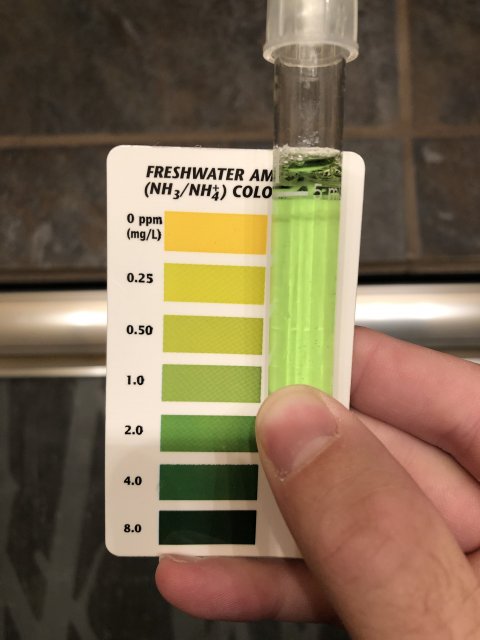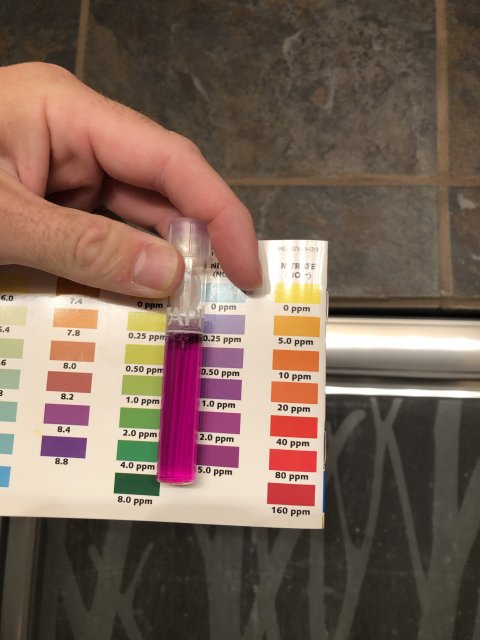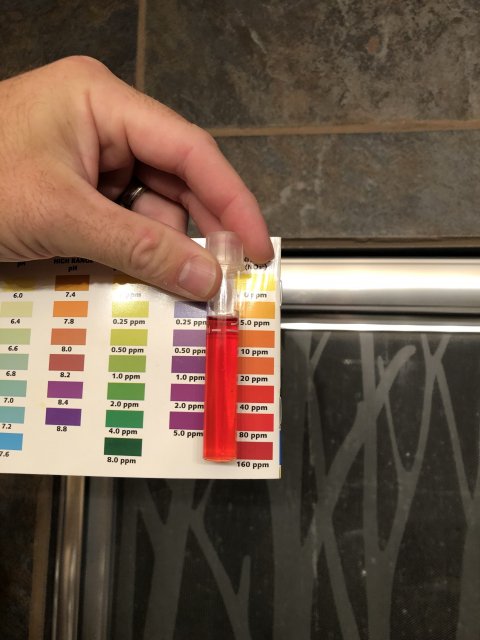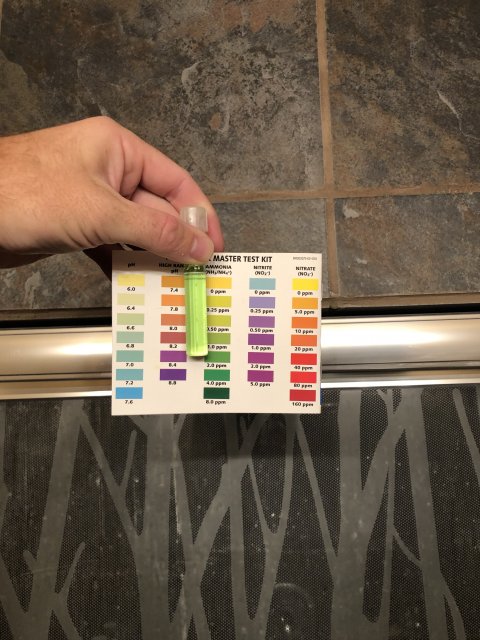Fishless Cycle
- Thread starter railer20
- Start date
You are using an out of date browser. It may not display this or other websites correctly.
You should upgrade or use an alternative browser.
You should upgrade or use an alternative browser.
I still cannot tell a thing about nitrite from that picture. It is not close in color to any of the bars as far as I can tell. In fact I would say I cannot see any difference in the color comparing all the pictures you have posted for nitrite. It is almost as if the light is too bright. The ammonia test is similar re color. The best I can offer is it is low. Nitrate looked like 40 to me.
I just realized that your pictures include the Nitrite bars 4 times. I count the other tests where the nitrite bars are also clearly visible. take a look at the color of the nitrite bars in each of the four pictures. No two are alike as far as I can see. You need to figure out how to get an accurate reading on your end as pictures are not helping me to have any idea of what the result is.
We are starting to go in circles with pictures and what you report about nitrite. I can only make two suggestions. One is to take a fresh water sample from your tank to your local store and ask them to test it and give you their opinion. The other is to get a different brand of Nitrite test kit and try that.
I suppose we could try to coax a diluted test by reducing the number of drops. The problem is you have to work in 20% increments since the test uses 5 drops. Therefore, here is what you would do based on how many drops are used. It assumes that as you reduce the number of drops you get a color match of which you are certain. The problem is the fewer drops used, the less accurate the result can be because we are working with pretty small volumes of water and drops can vary in size a tiny bit. Using more drops would tend to even out the potential variability. I suggest you start with three drops and if that doesn't help retest with two drops.
Use 4 drops and divide the result by .80
Use three drops and divide the result by .60
Use two drops and divide the result by .40
Use one drop and divide the result by .20
I am not even sure if doing the above one step at a time will end up giving you a color about which you feel confident.
I actually went to the Wichita water site and then also researched what might mess up a nitrite test at Hach.
The water report did not mention iron at all, but it did indicate a low level of copper. I doubt it is enough to be an issue also it is the ionic form that interferes.. Although the report was published in 2020, the testing for it was performed in 2019. So the data is not really current. The only reducing agent that you have added to the tank would be the dechlor, and that was a while back and the effect should be long gone.
I am not giving up here. I like a good challenge. But until we can get a reliable method for you to test nitrite levels......... However, I can say for sure that you have established some level of the cycle as ammonia drops and nitrate is produced.
I just realized that your pictures include the Nitrite bars 4 times. I count the other tests where the nitrite bars are also clearly visible. take a look at the color of the nitrite bars in each of the four pictures. No two are alike as far as I can see. You need to figure out how to get an accurate reading on your end as pictures are not helping me to have any idea of what the result is.
We are starting to go in circles with pictures and what you report about nitrite. I can only make two suggestions. One is to take a fresh water sample from your tank to your local store and ask them to test it and give you their opinion. The other is to get a different brand of Nitrite test kit and try that.
I suppose we could try to coax a diluted test by reducing the number of drops. The problem is you have to work in 20% increments since the test uses 5 drops. Therefore, here is what you would do based on how many drops are used. It assumes that as you reduce the number of drops you get a color match of which you are certain. The problem is the fewer drops used, the less accurate the result can be because we are working with pretty small volumes of water and drops can vary in size a tiny bit. Using more drops would tend to even out the potential variability. I suggest you start with three drops and if that doesn't help retest with two drops.
Use 4 drops and divide the result by .80
Use three drops and divide the result by .60
Use two drops and divide the result by .40
Use one drop and divide the result by .20
I am not even sure if doing the above one step at a time will end up giving you a color about which you feel confident.
I actually went to the Wichita water site and then also researched what might mess up a nitrite test at Hach.
Strong oxidizing and reducing substances interfere with the test. Cupric and ferrous ions cause low results. Ferric, mercurous, silver, bismuth, antimonous, lead, auric, chloroplatinate and metavanadate ions cause a precipitate to develop.
The water report did not mention iron at all, but it did indicate a low level of copper. I doubt it is enough to be an issue also it is the ionic form that interferes.. Although the report was published in 2020, the testing for it was performed in 2019. So the data is not really current. The only reducing agent that you have added to the tank would be the dechlor, and that was a while back and the effect should be long gone.
I am not giving up here. I like a good challenge. But until we can get a reliable method for you to test nitrite levels......... However, I can say for sure that you have established some level of the cycle as ammonia drops and nitrate is produced.
Ughh.. Yes. Deciphering that nitrite PPM is a nightmare by picture.
As TwoTankAmin mentioned, I've ordered/purchased new API test kits and the colors on the supplied charts varied some between kits! A small variance, but still a change.
We're almost forced to use them as a go / no-go gauge. Yellow ammonia test = go. Light blue nitrate = go. Wish it was that simple. You'l like to think the reagent kits are still more accurate than test strips.
Look at the bright side. One day, all you'll be checking for periodically is nitrate to get a feel for how much and how often you'll want to do water changes.
As TwoTankAmin mentioned, I've ordered/purchased new API test kits and the colors on the supplied charts varied some between kits! A small variance, but still a change.
We're almost forced to use them as a go / no-go gauge. Yellow ammonia test = go. Light blue nitrate = go. Wish it was that simple. You'l like to think the reagent kits are still more accurate than test strips.
Look at the bright side. One day, all you'll be checking for periodically is nitrate to get a feel for how much and how often you'll want to do water changes.
I’m just going to buy a new master kit at Petsmart. Mine technically doesn’t expire until 2024 but maybe I got a bad batch.
Or mail order one.
Hach make high quality test strips. They mostly read using the nitrogen scale. For 23 low range ammonia, which are good for tanks, the are $26.39. 25 strips that test both nitrite and nitrate will run you $24.55. So if a cycle goes on schedule you should be able to do two cycles for $51 + shipping.
https://www.hach.com/teststrips
Have fun, click on--> BROWSE ALL TEST STRIPS
https://www.hach.com/teststrips
Have fun, click on--> BROWSE ALL TEST STRIPS
So bought a new API test kids and then also kept her safe strips because they were on sale also.
API
Ammonia - lighter than .25 but not zero yet
Nitrite - same crap as before on the card colors, but if I measure against the card you sent in the messages the other day I would guess around 4ppm
Nitrate - approx 40
TETRASAFE STRIPS
Nitrite- 5 ppm
Nitrate - 40
Sidenote – no ammonia reading on the strip and chlorine did read zero
API
Ammonia - lighter than .25 but not zero yet
Nitrite - same crap as before on the card colors, but if I measure against the card you sent in the messages the other day I would guess around 4ppm
Nitrate - approx 40
TETRASAFE STRIPS
Nitrite- 5 ppm
Nitrate - 40
Sidenote – no ammonia reading on the strip and chlorine did read zero
Here is my best guess now. I think your ammonia is likely 0 or dang close. I am still not happy we have no accurate nitrite reading.
Based on there being 3.25 ppm of ammonia in the tank after the last addition, the most nitrite that could create was just over 8 ppm. This is of course using the total ion scale of the API tests. That gave us a headroom of another 8 ppm before stall-the-cycle levels would be reached. Until today that was being confirmed by the continued drop in ammonia. But once it is, or can be assumed to be, at 0, we lose that confirmation.
I really need to know where nitrite is by tomorrow because we are at the time to add more ammonia. If you can get a bottle of distilled (not spring) water. You can do a few quick diluted tests tonight and we should get a usable result. I am not fond of using the fewer drops in 5 ml method, if possible. What we are shooting for is to get a test result which match one of the top three bars on the nitrite test card. Then multiply from there. (Btw, that distilled water is great for making coffee if you drink it.)
Based on there being 3.25 ppm of ammonia in the tank after the last addition, the most nitrite that could create was just over 8 ppm. This is of course using the total ion scale of the API tests. That gave us a headroom of another 8 ppm before stall-the-cycle levels would be reached. Until today that was being confirmed by the continued drop in ammonia. But once it is, or can be assumed to be, at 0, we lose that confirmation.
I really need to know where nitrite is by tomorrow because we are at the time to add more ammonia. If you can get a bottle of distilled (not spring) water. You can do a few quick diluted tests tonight and we should get a usable result. I am not fond of using the fewer drops in 5 ml method, if possible. What we are shooting for is to get a test result which match one of the top three bars on the nitrite test card. Then multiply from there. (Btw, that distilled water is great for making coffee if you drink it.)









